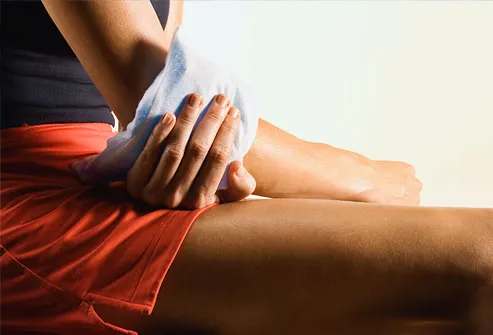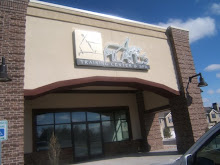Sunday, February 27, 2011
Keep Your Joints Healthy
 About 21 million adults have osteoarthritis -- the wear-and-tear condition that causes achy joints and may eventually lead to can't-get-up-from-the-sofa pain.
About 21 million adults have osteoarthritis -- the wear-and-tear condition that causes achy joints and may eventually lead to can't-get-up-from-the-sofa pain."A third to half of doctor visits deal with musculoskeletal issues. They're one of the most common health problems," says Sharon Kolasinski, M.D., an associate professor of clinical medicine at the University of Pennsylvania. Depending on risk factors, joint pain can affect anyone, though osteoarthritis mostly starts as our bodies begin to show the effects of aging.
In women, it occurs more frequently after age 50; in men, it's more likely before age 45. Also, sites of joint pain are different. Women are more likely to develop osteoarthritis in their hands, knees, ankles, or feet, while men are more likely to develop it in their wrists, hips, or spine.
But just because a condition is prevalent doesn't mean it's inevitable, or that you can't do a number of things to either prevent or control it. Here are the basics of how your joints function and how to keep them moving smoothly.
 There are various kinds of joints; shoulders have a ball-and-socket-type construction, while knees work more like door hinges. Still, all joints have the same basic anatomy and function: They connect one bone to another to give us the ability to bend, twist, or win dancing contests.
There are various kinds of joints; shoulders have a ball-and-socket-type construction, while knees work more like door hinges. Still, all joints have the same basic anatomy and function: They connect one bone to another to give us the ability to bend, twist, or win dancing contests.Inside a joint, similar features reside. There's the connective tissue -- the ligament, which essentially serves as a bridge from one bone to the other via your muscles. There's also cartilage -- a fibrous and somewhat elastic tissue that acts as a cushioning material between joints. Cartilage acts as a shock absorber to prevent bones from grinding against each other.
Osteoarthritis appears when we start to lose that cushioning, and a number of factors contribute cumulatively to the loss.
Aging: "Cartilage thins as we age," says David Felson, M.D., professor of medicine at Boston University, who specializes in bone and joint problems. "That makes it easier to damage." Over time, the surface of cartilage can change from smooth to fissured. That's when erosions in cartilage begin to appear.
 Previous injuries: Seemingly minor joint injuries (an unlucky twist here or there) when you were younger can be a factor. "Even people who don't remember injuries see areas of damage with age," Felson says.
Previous injuries: Seemingly minor joint injuries (an unlucky twist here or there) when you were younger can be a factor. "Even people who don't remember injuries see areas of damage with age," Felson says.Inflammation: Small injuries upset the biomechanics of your joints. That, in turn, changes the molecules that make up cartilage. "Part of the destructive process of osteoarthritis is that microtraumatic injuries can cause low levels of inflammation," Kolasinski says. "Inflammatory cells can gather at a site of injury and release chemicals destructive to cartilage."
Loss of muscle mass: Everyone naturally loses some muscle mass as they age. If you don't work to maintain it, your joint -- instead of your muscle -- will absorb more of the pounding from daily living, and that contributes to more damage.
 Excess weight: The more a joint has to carry, the more damage it experiences in the long run. This is especially true for knees, which have to support your body weight. "All these little wear-and-tear events throughout life erode cartilage," Kolasinski says. "The cushion can get thinner until there's nothing left."
Excess weight: The more a joint has to carry, the more damage it experiences in the long run. This is especially true for knees, which have to support your body weight. "All these little wear-and-tear events throughout life erode cartilage," Kolasinski says. "The cushion can get thinner until there's nothing left."You can't bring back cartilage that's already lost.
However, there are several common-sense steps you can take to either prevent the wear or reduce the pain associated with osteoarthritis.
Maintain a healthy weight. It's the best thing you can do to preserve your joints. Keeping your weight down will help reduce those small tears that break down cartilage. In fact, a weight loss of as little as 11 pounds can reduce arthritis pain by 50 percent for many women. Weight loss may also help slow the progression of osteoarthritis over time.
Vary your exercise. Working out helps reduce stiffness in the joints. Kolasinski recommends varying your exercise routine -- low- or no-impact aerobic exercises (swimming, walking, or cycling) twice a week, strength exercises (lifting light weights or household items) twice a week, mixed with stretching and relaxation exercises.
"You don't want to overtax any one area, because that'll increase pain, and then you might avoid exercise altogether," Kolasinski says.Keep your muscles in mind. Weight training helps strengthen the muscles and ligaments surrounding joints, protecting them from damage. Modify muscle-building moves so they don't strain the joint of the part you're exercising. For example, Kolasinski advises that people with arthritis do seated leg lifts instead of squats and lunges, which can increase pressure on the knee. Sit on a chair with both feet on the floor. Bend your knee and raise your leg so it's parallel to the floor. You can do one leg at a time or both; as the exercise becomes easier, you can add ankle weights to increase the resistance and build even more muscle strength.
Add ice. Icing your joints after exercise can help you manage pain and prevent swelling. When you exercise, you draw a lubricant called synovial fluid to your joints. But if the fluid sticks around too long after exercise, it can cause cracks in the cartilage. "Ice gets the fluid out of the joint and into the lymphatic system, the garbage disposal of the body," says Kevin Olds, M.S.P.T., C.S.C.S., a physical therapist at Campbell Clinic in Memphis, Tennessee. Olds suggests icing the joints you use during exercise for 10 minutes after the activity.
Late last year, a study of 1,583 knee osteoarthritis patients conducted by the University of Utah School of Medicine found that glucosamine and chondroitin sulfate -- two of the most popular dietary supplements used as alternative therapies to treat osteoarthritis -- provided a modicum of pain relief for patients whose arthritis was deemed moderate to severe. However, people in the study with milder forms of arthritis pain reported no benefit whatsoever.
Source: CNN.com
Subscribe to:
Post Comments (Atom)

Aspire Pilates Training Center & Spa
2464 W. 12600 S. Suite 190
Riverton, Utah 84065
801-302-5720
www.aspireptc.com
About Me
Blog Archive
-
▼
2011
(42)
-
▼
February
(34)
- 8 Ways to Stick to Your Diet While Friends Indulge
- Keep Your Joints Healthy
- Almond Crunch Arbonne Protein Shake
- Importance of Sleep
- Vitamin C
- Crispy Nut Butter Treats
- Sweeteners
- Water
- Dietary fiber: Essential for a healthy diet
- Piña Colada Arbonne Protein Shake
- Aerobic exercise: How to warm up and cool down
- Minerals
- Gluten Free & Vegan Peppermint Patties
- Face the Fats
- Finishing up Week 2 of the 28 Day Challenge....
- Happy Valentine's!
- What is YOUR Goal? ...
- Digestive Enzymes
- Nutty Apple Cinnamon Arbonne Protein Shake
- Relaxation
- Stress
- B Vitamins
- Arbonne Protein Powder Pancakes
- Good Carbs vs Bad Carbs
- First Week of 28 Day Challenge....
- Detoxification
- Probiotics
- Pumpkin Spice Protein Shake
- Cardio vs Strength Training
- Vitamin D
- Perfect Form
- Arbonne Protein Bars Recipe
- Monster Lo-Carb Energy Drink Vs Arbonne Fizz-tabs ...
- Proteins
-
▼
February
(34)
Followers
Powered by Blogger.



0 comments:
Post a Comment